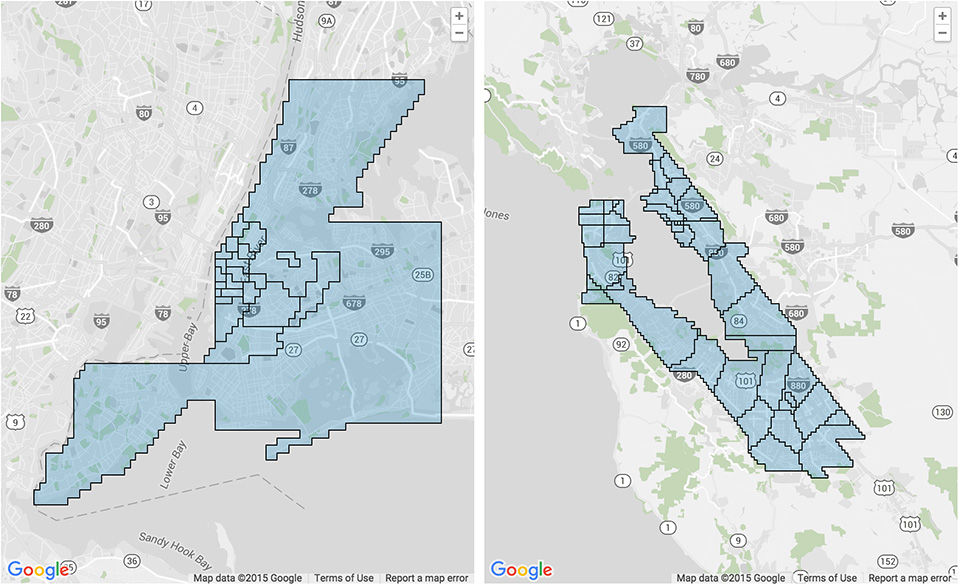By Lauren Kirchner and Surya Mattu/ProPublica
Uber has long stirred controversy and consternation over the higher “surge” prices it charges at peak times. The company has always said the higher prices actually help passengers by encouraging more drivers to get on the road. But computer scientists from Northeastern University have found that higher prices don’t necessarily result in more drivers.
Researchers Le Chen, Alan Mislove and Christo Wilson created 43 new Uber accounts and virtually hailed cars over four weeks from fixed points throughout San Francisco and Manhattan. They found that many drivers actually leave surge areas in anticipation of fewer people ordering rides.
“What happens during a surge is, it just kills demand,” Wilson told ProPublica. “So the drivers actually drive away from the surge.”
When contacted this week, Uber said that their own analysis has shown that surge pricing does, in fact, attract more drivers to surge areas.
“Contrary to the findings in this report – which is based on extremely limited, public data – we’ve seen this work in practice day in day out, in cities all around the world,” Uber spokeswoman Molly Spaeth wrote in an e-mail.
The researchers also uncovered a few tips about how to avoid surge prices. They found that changing your location, even by a few hundred feet, can influence the price you get. They also discovered that you can often get back to normal fare levels by waiting as few as five minutes.
“The vast majority of surges are short-lived, which suggests that savvy Uber passengers should ‘wait-out’ surges rather than pay higher prices,” the authors wrote in a new study they are presenting at a conference in Tokyo on Friday.
The Northeastern scientists found that Uber’s price scheme divides cities into “surge areas” and calculates prices for each one independently. The boundaries are not known to consumers.
“[T]wo users standing a few meters apart may unknowingly receive dramatically different surge multipliers,” the scientists wrote. “For example, 20 percent of the time in Times Square, customers can save 50 percent or more by being in an adjacent surge area” a block or two away.
The researchers sketched out those boundaries in their paper, and ProPublica has developed them into maps. (EXPAND)

Uber users in Manhattan can more easily cross from current surging to non-surging zones than users in San Francisco. The areas in Manhattan are smaller, and therefore more walkable; San Francisco’s price areas also tend to surge together.
The Northeastern researchers also found significant differences between the San Francisco and Manhattan markets. While an Uber blog post last year stated that surge pricing “affects a tiny minority of all Uber rides, less than 10 percent of trips,” the researchers documented that the price of Uber in Manhattan surged about 14 percent of the time, and 57 percent of the time in San Francisco.
When asked about these findings, Uber said that they sounded unrepresentative, but not outside of the realm of possibility.
Like other online marketplaces in the “sharing economy,” Uber promises efficiency and openness. When using Craigslist, AirBnb, or eBay, for instance, buyers and sellers have the same information about what products are available, and for how much – both sides have a lot of information with which to make price comparisons. Uber is an outlier, these researchers explained, because under the Uber model, neither side of the transaction has all of the information.
“With Uber, the drivers don’t know what’s going on, and the customers don’t know what’s going on,” said Wilson. “There’s an algorithm behind the scenes that determines what the prices are, and you essentially have no idea what’s happening.”
–
Previously:
* Uber Claims Credit For Drop In Drunk Driving Accidents. But Where’s The Evidence?
* Uber Uber Alles.
–
ProPublica is a Pulitzer Prize-winning investigative newsroom. Sign up for their newsletter.
–
Comments welcome.
Posted on October 30, 2015


